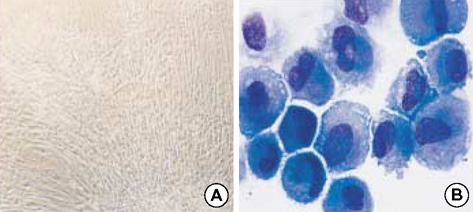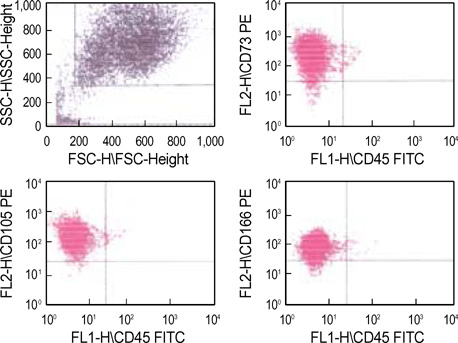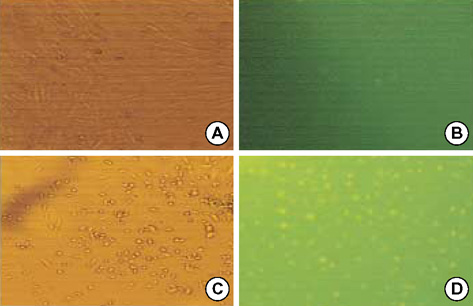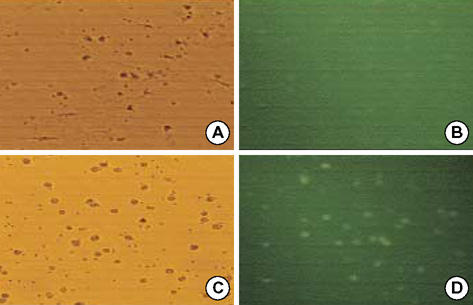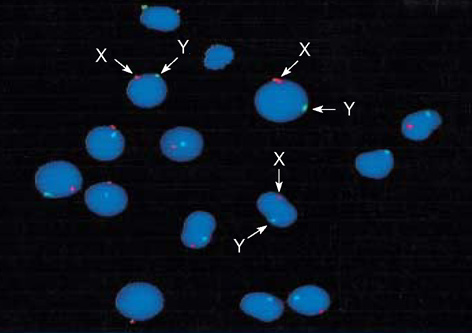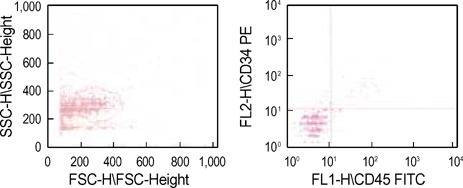J Korean Med Sci.
2007 Apr;22(2):242-247. 10.3346/jkms.2007.22.2.242.
Cotransplantation of Cord Blood Hematopoietic Stem Cells and Culture-Expanded and GM-CSF-/SCF-Transfected Mesenchymal Stem Cells in SCID Mice
- Affiliations
-
- 1Department of Laboratory Medicine, Dong-A University College of Medicine, 1 3-ga, Dongdaesin-dong, Seo-gu, Busan, Korea. jyhan@dau.ac.kr
- 2Department of Microbiology, Dong-A University College of Medicine, Busan, Korea.
- 3Department of Pharmacology, Dong-A University College of Medicine, Busan, Korea.
- 4Department of Internal Medicine, Dong-A University College of Medicine, Busan, Korea.
- 5Department of Pediatrics, Hanyang University College of Medicine, Seoul, Korea.
- KMID: 1713176
- DOI: http://doi.org/10.3346/jkms.2007.22.2.242
Abstract
- Mesenchymal stem cells (MSC) are multipotent in nature and believed to facilitate the engraftment of hematopoietic stem cells (HSC) when transplanted simultaneously in animal studies and even in human trials. In this study, we transfected culture-expanded MSC with granulocyte macrophage-colony stimulating factor (GMCSF) and stem cell factor (SCF) cytokine genes and then cotransplanted with mononuclear cells (MNC) to further promote HSC engraftment. MNC were harvested from cord blood and seeded in long-term culture for ex vivo MSC expansion. A total of 1 x 10(7) MNC plus MSC/microliter were introduced to the tail vein of nonobese diabetic/severe combined immunodeficiency mice. After 6-8 weeks later, homing and engraftment of human cells were determined by flow cytometry and fluorescence in situ hybridization studies. The total nucleated cell count and the engraftment of CD45+/CD34+ cells and XX or XY positive human cells were significantly increased in cotransplanted mice and even higher with the cytokine gene-transfected MSC (GM-CSF>SCF, p<0.05) than in transplantation of MNC alone. These results suggest that MSC transfected with hematopoietic growth factor genes are capable of enhancing the hematopoietic engraftment. Delivering genes involved in homing and cell adhesions, CXCR4 or VLA, would further increase the efficiency of stem cell transplantation in the future.
Keyword
MeSH Terms
-
Transfection/*methods
Stem Cell Factor/genetics/*metabolism
Mice, SCID
Mice
Mesenchymal Stem Cells/*metabolism
Mesenchymal Stem Cell Transplantation/*methods
Hematopoietic Stem Cell Transplantation/*methods
Granulocyte Macrophage Colony-Stimulating Factors, Recombinant/*metabolism
Graft Survival/*immunology
Genetic Enhancement/methods
Animals
Figure
Reference
-
1. Kassem M. Mesenchymal stem cells: biological characteristics and potential clinical applications. Cloning Stem Cells. 2004. 6:369–374.
Article2. Le Blanc K, Pittenger MF. Mesenchymal stem cells: progress toward promise. Cytotherapy. 2005. 7:36–45.
Article3. Kan I, Melamed E, Offen D. Integral therapeutic potential of bone marrow mesenchymal stem cells. Curr Drug Targets. 2005. 6:31–41.
Article4. Jiang Y, Jahagirdar BN, Reinhardt RL, Schwartz RE, Keene CD, Ortiz-Gonzalez XR, Reyes M, Lenvik T, Lund T, Blackstad M, Du J, Aldrich S, Lisberg A, Low WC, Largaespada DA, Verfaillie CM. Pluripotency of mesenchymal stem cells derived from adult marrow. Nature. 2002. 418:41–49.
Article5. Jones EA, Kinsey SE, English A, Jones RA, Straszynski L, Meredith DM, Markham AF, Jack A, Emery P, McGonagle D. Isolation and characterization of bone marrow multipotential mesenchymal progenitor cells. Arthritis Rheum. 2002. 46:3349–3360.
Article6. Erices A, Conget P, Minguell JJ. Mesenchymal progenitor cells in human umbilical cord blood. Br J Haematol. 2000. 109:235–242.
Article7. Goodwin HS, Bicknese AR, Chien SN, Bogucki BD, Oliver DA, Quinn CO, Wall DA. Multilineage differentiation activity by cells isolated from umbilical cord blood: expression of bone, fat, and neural markers. Biol Blood Marrow Transplant. 2001. 7:581–588.
Article8. Erices AA, Allers CI, Conget PA, Rojas CV, Minguell JJ. Human cord blood-derived mesenchymal stem cells home and survive in the marrow of immunodeficient mice after systemic infusion. Cell Transplant. 2003. 12:555–561.
Article9. Huss R, Lange C, Weissinger EM, Kolb HJ, Thalmeier K. Evidence of peripheral blood-derived, plastic-adherent CD34(-/low) hematopoietic stem cell clones with mesenchymal stem cell characteristics. Stem Cells. 2000. 18:252–260.10. Villaron EM, Almeida J, Lopez-Holgado N, Alcoceba M, Sanchez-Abarca LI, Sanchez-Guizo FM, Alberca M, Perez-Simon JA, San Miguel JF, Del Canizo MC. Mesenchymal stem cells are present in peripheral blood and can engraft after allogeneic hematopoietic stem cell transplantation. Haematologica. 2004. 89:1421–1427.11. Studeny M, Marini FC, Champlin RE, Zompetta C, Fidler IJ, Andreeff M. Bone marrow-derived mesenchymal stem cells as vehicles for interferon-β delivery into tumors. Cancer Res. 2002. 62:3603–3608.12. Studeny M, Marini FC, Dembinski JL, Zompetta C, Cabreira-Hansen M, Bekele BN, Champlin RE, Andreeff M. Mesenchymal stem cells: potential precursors for tumor stroma and targeted-delivery vehicles for anticancer agents. J Natl Cancer Inst. 2004. 96:1593–1603.
Article13. Hamada H, Kobune M, Nakamura K, Kawano Y, Kato K, Honmou O, Houkin K, Matsunaga T, Niitsu Y. Mesenchymal stem cells (MSC) as therapeutic cytoreagents for gene therapy. Cancer Sci. 2005. 96:149–156.
Article14. Nakashima S, Matsuyama Y, Nitta A, Sakai Y, Ishiguro N. Highly efficient transfection of human marrow stromal cells by nucleofection. Transplant Proc. 2005. 37:2290–2292.
Article15. Martinet W, Schrijvers DM, Kockx MM. Nucleofection as an efficient nonviral transfection method for human monocytic cells. Biotechnol Lett. 2003. 25:1025–1029.16. Lee YH, Han JY, Seo SY, Kim KH, Lee YA, Lee YS, Lee HS, Hur WJ, Han H, Kwon HC, Kim JS, Kim HJ. Stem cells expressing homing receptors could be expanded from cryopreserved and unselected cord blood. J Korean Med Sci. 2001. 19:635–639.
Article17. Ramirez M, Segovia JC, Benet I, Arbona C, Guenechea G, Blaya C, Garcia-Conde J, Bueren JA, Prosper C. Ex vivo expansion of umbilical cord blood (UCB) CD34+ cells alters the expression and function of α 4 β 1 and α 5 β 1 integrins. Br J Haematol. 2001. 115:213–221.18. Noort WA, Kruisselbrink AB, in't Anker PS, Kruger M, van Bezooijen RL, de Paus RA, Heemskerk MH, Lowik CW, Falkenburg JH, Willemze R, Fibbe WE. Mesenchymal stem cells promote engraftment of human umbilical cord blood-derived CD34+ cells in NOD/SCID mice. Exp Hematol. 2002. 30:870–878.
Article19. in't Anker PS, Noort WA, Kruisselbrink AB, Scherjon SA, Beekhuizen W, Willemze R, Kanhai HH, Fibbe WE. Nonexpanded primary lung and bone marrow-derived mesenchymal cells promote the engraftment of umbilical cord blood-derived CD34+ cells in NOD/SCID mice. Exp Hematol. 2003. 31:881–889.20. Angelopoulou M, Novelli E, Grove JE, Rinder HM, Civin C, Cheng L, Krause DS. Cotransplantation of human mesenchymal stem cells enhances human myelopoiesis and megakaryocytopoiesis in NOD/SCID mice. Exp Hematol. 2003. 31:413–420.
Article21. Bensidhoum M, Chapel A, Francois S, Demarquay C, Mazurier C, Fouillard L, Bouchet S, Bertho JM, Gourmelon P, Aigueperse J, Charbord P, Gorin NC, Thierry D, Lopez M. Homing of in vitro expanded Stro-1- or Stro-1+ human mesenchymal stem cells into the NOD/SCID mouse and their role in supporting human CD34 cell engraftment. Blood. 2004. 103:3313–3319.
Article22. Lazarus HM, Koc ON, Devine SM, Curtin P, Maziarz RT, Holland HK, Shpall EJ, McCarthy P, Atkinson K, Cooper BW, Gerson SL, Laughlin MJ, Loberiza FR Jr, Moseley AB, Bacigalupo A. Cotransplantation of HLA-identical sibling culture-expanded mesenchymal stem cells and hematopoietic stem cells in hematologic malignancy patients. Biol Blood Marrow Transplant. 2005. 11:389–398.
Article23. Majumdar MK, Thiede MA, Haynesworth SE, Bruder SP, Gerson SL. Human marrow-derived mesenchymal stem cells (MSCs) express hematopoietic cytokines and support long-term hematopoiesis when differentiated toward Stromal and osteogenic lineages. J Hematother Stem Cell Res. 2000. 9:841–848.
Article24. Chung NG, Jeong DC, Park SJ, Choi BO, Cho B, Kim HK, Chun CS, Won JH, Han CW. Cotransplantation of marrow stromal cells may prevent lethal graft-versus-host disease in major histocompatibility complex mismatched murine hematopoietic stem cell transplantation. Int J Hematol. 2004. 80:370–376.
Article25. Maitra B, Szekely E, Gjini K, Laughlin MJ, Dennis J, Haynesworth SE, Koc ON. Human mesenchymal stem cells support unrelated donor hematopoietic stem cells and suppress T-cell activation. Bone Marrow Transplant. 2004. 33:597–604.
Article26. Wagner W, Wein F, Seckinger A, Frankhauser M, Wirkner U, Krause U, Blake J, Schwager C, Eckstein V, Ansorge W, Ho AD. Comparative characteristics of mesenchymal stem cells from human bone marrow, adipose tissue, and umbilical cord blood. Exp Hematol. 2005. 33:1402–1416.
Article27. Bieback K, Kern S, Kluter H, Eichler H. Clinical parameters for the isolation of mesenchymal stem cells from umbilical cord blood. Stem Cells. 2004. 22:625–634.
- Full Text Links
- Actions
-
Cited
- CITED
-
- Close
- Share
- Similar articles
-
- Ex Vivo Expansion of Cryopreserved Cord Blood Cells
- Cotransplanted Bone Marrow Derived Mesenchymal Stem Cells (MSC) Enhanced Engraftment of Hematopoietic Stem Cells in a MSC-dose Dependent Manner in NOD/SCID Mice
- Ex Vivo Expansion of Primitive Hematopoietic Cells by Using Hematopoietic Growth Factors
- Endothelial progenitor cells and mesenchymal stem cells from human cord blood
- Cell Therapy in Hematopoietic Stem Cell Transplantation

